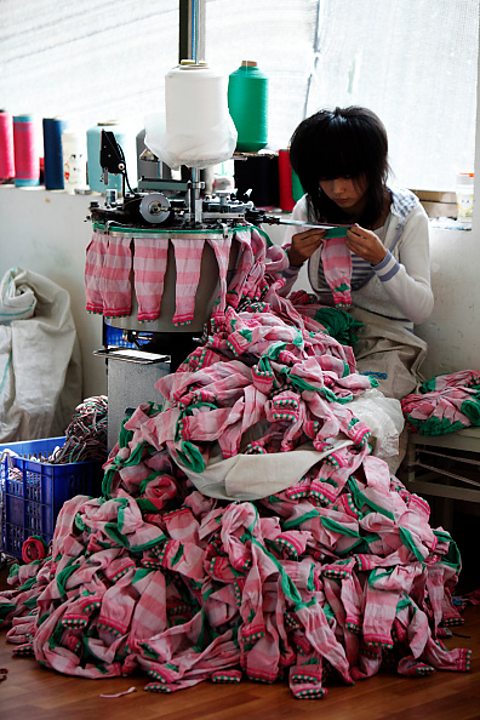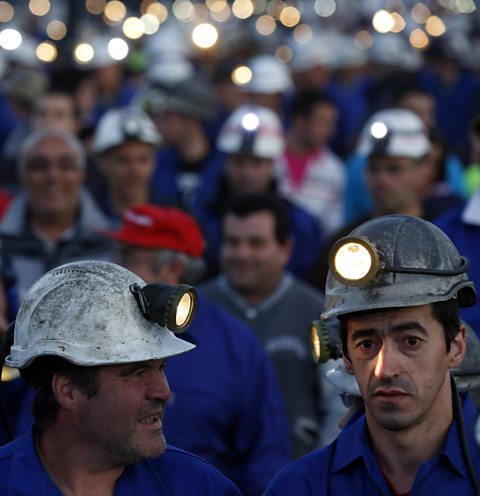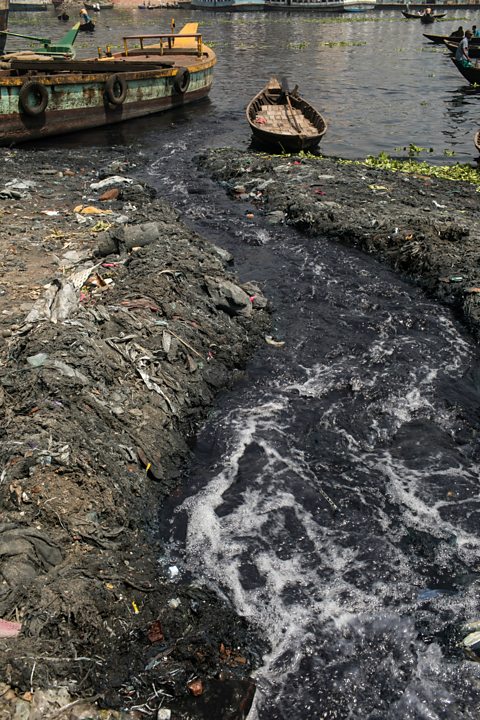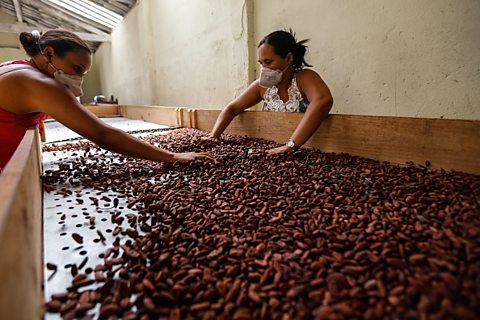Types of industry
Industry is any economic activity which creates jobs and generates income.
There are four main types of industry:
- Primary sector
- Secondary sector
- Tertiary sector
- Quaternary sector
Primary industry involves the production or extraction of raw materials and includes forestry, farming, fishing and mining.
Secondary industry is the manufacturing of goods. For example, the northwest of England used to have a thriving textile industry making cloth from cotton, China has a thriving manufacturing sector producing electronics, and Germany is one of the largest manufacturers of cars.
Tertiary industry involves providing services to people, for example a cleaner or a doctor.
Quaternary industry is the newest sector and focuses on knowledge-based industries or high-tech industries such as ICT (information and communication technologies) and research and development.
The Clark Fisher model shows how a country changes its focus.
The effects of industry
Different countries around the world are at different stages of industrial development and there are regional variations within countries. Countries rely on each other for the manufacture and sale of goods to take place. For example, raw materials may be bought in one country, used to manufacture goods in another, and then sold in a third country. This can have positive benefits as it improves co-operation between countries through international trade but can also be a source of conflict.
As countries develop, they move through the phases of the Clark Fisher model. When a country no longer mainly manufactures goods and moves into the service sector, this is known as de-industrialisation.
Economic effects

The transition of phases (Clark Fisher model) can happen for a number of reasons but one of the most significant is the off shoring of manufacturing from a high-income country (HIC) to a low-income country (LIC) or a newly emerging economy (NEE). An example of this is the relocation of aero plane engine production from Barnoldswick in Lancashire, in the UK, to Singapore. This is done for a number of reasons:
- To increase profits by exploiting the lower cost of labour by paying lower wages.
- To take advantage of less rigorous rules for example fewer environmental or health and safety laws.
Social effects

When primary and secondary industries, and their workers, are abandoned in favour of new industries this can lead to conflict within a country.
This happened in the United Kingdom in the 1980s as the government decided to move from the secondary sector to a new phase of post-industrialism, where the tertiary and quaternary sectors were encouraged.
The decline in primary and secondary industries in many places has led to unemployment and many other social issues.
The countries who benefit from a decline elsewhere in primary and secondary industries are the newly emerging economies (NEEs). Nigeria, for example, as it moves into the industrial phase of their development and begins to develop tertiary industries, can use the money generated to improve schools, hospitals and infrastructure in the country and provide jobs for the workforce.
Environmental effects

There may also be negatives for these countries as industry can be polluting.
For example, leather manufacturing is one of the largest causes of pollution in the River Ganges in India. This includes waste water from factories being released into rivers and lakes along with chemicals.
Increasingly there are calls for a new ‘Green Industrial Revolution’ in manufacturing with a move away from polluting industries such as energy production using fossil fuels towards the development of green, environmentally friendly, technology such as wind turbines.
In 2020 the UK government announced a ten-point plan for a green industrial revolution to support green jobs and move towards a zero-carbon economy.
Political effects

Low-income countries (LICs) tend to still rely on the export of raw materials, such as cocoa beans, to more developed countries to be converted into manufactured goods, such as chocolate. This can lead to exploitation of the poorer countries by those who are richer and reinforces the dominance of already powerful nations.
Question
When a country no longer focuses on manufacturing goods and moves into the service sector what is this process called?
When a country no longer focuses on manufacturing goods and moves into the service sector this is known as de-industrialisation.
Secondary industry
Examples of secondary manufacturing industries of different scales are:
(a) small-scale: engineering in the Punjab,
(b) medium-scale: Sterling Plywood Industry in Karachi, Processing Industries in Malaysia and Sri Lanka,
(c) large-scale: iron and steel in Pakistan and Japan
rali making – a household industry in Sindh
carpet weaving on small scale
small scale engineering in the Punjab
Define ‘tertiary industry’. [1]
………………………………………………………………………………………………………………………….
……………………………………………………………………………………………………………………. [1]
Name two examples of a tertiary occupation.
1 …………………………………………….
2 ……………………………………………. [2]
Define ‘formal’ and ‘informal’ sectors of industry. [2]
State two job types found in the formal sector and the informal sector of the tourism industry. [4]
| Jobs in the informal sector | Jobs in the formal sector |
| 1 | 1 |
| 2 | 2 |
State two advantages and two disadvantages of the informal sector to the tourist industry in Pakistan. [4]
| Advantages | Disadvantages |
| 1 | |
| 2 |
Study the following figure, a divided bar graph showing the international tourism revenue for different world regions in 2017 as a percentage of the world total.
Using the figure only:
– which region had the highest percentage of the world total?
………………………………………………………..
– which region accounted for 3% of the world total?
………………………………………………………..
– what percentage of the world total was accounted for by the Asia‑Pacific region?
…………………………………..% [3]
Study the following figure, a photograph showing a tourist attraction in Pakistan.
Describe two attractions to tourists of the area shown.
1 ……………………………………………………………………………………………………………………….
………………………………………………………………………………………………………………………….
2 ……………………………………………………………………………………………………………………….
…………………………………………………………………………………………………………………………. [2]
Name and describe three cultural attractions of Pakistan.
1 ……………………………………………………………………………………………………………………….
………………………………………………………………………………………………………………………….
2 ……………………………………………………………………………………………………………………….
………………………………………………………………………………………………………………………….
3 ……………………………………………………………………………………………………………………….
…………………………………………………………………………………………………………………………. [3]
Study the figure, a photograph taken inside a steel mill in Pakistan.
Using the figure only, describe three features of the steel mill shown.
1 ……………………………………………………………………………………………………………………….
………………………………………………………………………………………………………………………….
2 ……………………………………………………………………………………………………………………….
………………………………………………………………………………………………………………………….
3 ……………………………………………………………………………………………………………………….
…………………………………………………………………………………………………………………………. [3]
Explain two factors influencing the location of the iron and steel industry in Pakistan. You
should develop your answer.
1 ………………………………………………………………………………………………………………………………
…………………………………………………………………………………………………………………………………
…………………………………………………………………………………………………………………………………
…………………………………………………………………………………………………………………………………
2 ………………………………………………………………………………………………………………………………
…………………………………………………………………………………………………………………………………
…………………………………………………………………………………………………………………………………
………………………………………………………………………………………………………………………………… [4]
Study the following figure, a photograph of an area near Karachi used by tourists.
Using the figure only, state two natural attractions of the area shown.
1 …………………………………………….
2 ……………………………………………. [2]
Suggest how tourists may use the area shown in the above figure.
………………………………………………………………………………………………………………………….
………………………………………………………………………………………………………………………….
………………………………………………………………………………………………………………………….
………………………………………………………………………………………………………………………….
………………………………………………………………………………………………………………………….
……………………………………………………………………………………………………………………. [3]
Describe two features of large-scale industry.
1 ……………………………………………………………………………………………………………………….
………………………………………………………………………………………………………………………….
2 ……………………………………………………………………………………………………………………….
…………………………………………………………………………………………………………………………. [2]
Study the following figure, a diagram showing oil prospecting and drilling.
Complete the labels on Fig. 3.1 by choosing the correct words from the list below.
derrick drill pipe refinery valves [2]
Complete the following figure, which is a divided bar graph, using the information below to show the
employment structure of Pakistan:
Complete the table by classifying the jobs from the list below into the correct categories.
An example has been done for you.
Define the term ‘secondary industry’.
………………………………………………………………………………………………………………………….
………………………………………………………………………………………………………………………[1]
State a feature of each of the following types of industry:
cottage industries; ……………………………………………………………………………………………….
………………………………………………………………………………………………………………………….
small-scale industries; ………………………………………………………………………………………….
………………………………………………………………………………………………………………………….
large-scale industries. ………………………………………………………………………………………….
………………………………………………………………………………………………………………………[3]













